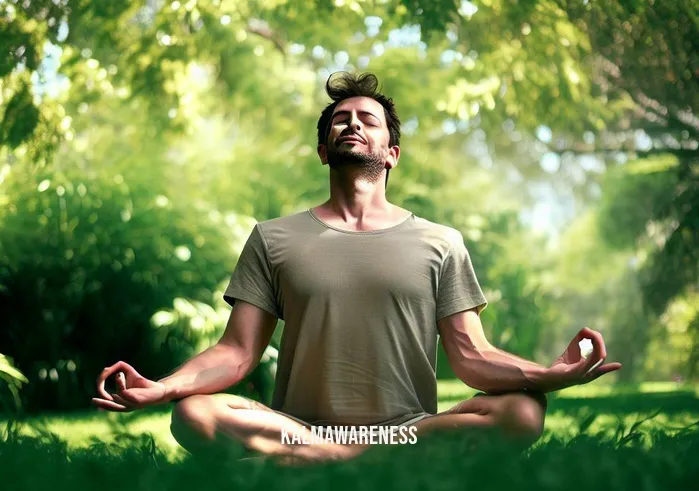The Magic of 5.5 Breaths Per Minute: A Journey into Relaxation
In the hustle and bustle of today’s world, finding a moment of tranquility can feel like an expedition. But what if I told you that tranquility is just 5.5 breaths away? The secret lies in the rhythm of your breath, where 5.5 breaths per minute can transform stress into serenity.
It’s time to unlock the door to inner peace with a deep dive into this potent technique. So get comfortable, perhaps in a position suggested in Get Ready to Learn Seated 1, and let’s embark on this breath-led journey.

What is 5.5 Breaths Per Minute?
In the realm of mindfulness and meditation, breathing techniques are the powerful tools that hold the potential to reshape our mind-body connection. One such technique is maintaining a rhythm of 5.5 breaths per minute, a cadence found to promote a meditative state. It might sound strange, after all, isn’t it natural to breathe without counting? But this specific pattern has been observed in numerous meditation practices, including some deep guided journey meditations, as a means to deepen the relaxation experience.
The beauty of this technique is its simplicity. No additional props or fancy postures, just you and your breath – that gentle air movement that we often take for granted. It might take some practice to maintain this pace – after all, the average person breathes approximately 12-20 times per minute – but once mastered, it’s a game-changer.
The Science Behind the Breath
The science behind the ‘5.5 breaths per minute’ technique is as intriguing as the practice itself. This breathing pattern falls within the frequency of our natural respiratory sinus arrhythmia, which is closely linked to the heart’s rhythm and our autonomic nervous system. And if you’re wondering how it feels after practising this, you might want to explore how-do-you-feel-after-meditation.
Engaging in this slower breath pattern activates the parasympathetic response – our body’s rest and digest mode. It balances the stress-induced fight or flight response from our sympathetic nervous system, leading to a calming effect. Imagine feeling the tranquility of a guided meditation journey just by controlling your breath – that’s the power of this technique.
If you’re dealing with back pain, you might find relief with this breathing technique, which has been shown to reduce muscle tension. To enhance this benefit, you can combine it with this guided meditation for back pain.
This concludes the first segment of our exploration into the 5.5 breaths per minute technique. As we take a pause, I invite you to continue with us in the next part, where we will delve deeper into the practice of this transformative breathing technique, and uncover how to integrate it into your daily routine for optimal relaxation.
Embracing the Practice of 5.5 Breaths Per Minute
Having understood the theoretical backdrop of the ‘5.5 breaths per minute’ technique, it’s time to dip our toes into the actual practice. The key to making this technique effective is consistency, persistence, and a dash of patience. It’s essential to maintain a non-judgemental attitude during the practice, similar to the mindset nurtured in mindful movement meditations.
Finding Your Rhythm
“When the breath wanders the mind also is unsteady. But when the breath is calmed the mind too will be still, and the yogi achieves long life. Therefore, one should learn to control the breath.” – Hatha Yoga Pradipika

This ancient wisdom holds true even today. Finding the rhythm for 5.5 breaths per minute means you’ll be taking approximately one breath every 11 seconds – inhaling for about 5.5 seconds, and exhaling for the same duration. To ease into this pattern, you may start by trying a five-minute morning meditation.
A common challenge for beginners is dealing with discomfort during meditation, whether it’s feeling hot or itchy. Our articles on feeling hot during meditation and itching during meditation offer useful insights on these issues.
Visualizing Your Breath
Visualization can be a powerful tool to keep your attention focused on your breath. One popular method is the ‘flower breathing’ technique. As you inhale, imagine a beautiful flower blooming, and as you exhale, visualize the flower closing its petals. You can explore more about this technique in our flower meditation script.
Enhancing the Experience
The beauty of the ‘5.5 breaths per minute’ technique lies in its versatility. You can integrate it with your favorite relaxation practices. For instance, you can use it during a guided meditation for pelvic floor relaxation or enhance a guided sleep meditation with music by maintaining this breath pattern.
Embracing the ‘5.5 breaths per minute’ technique is like opening a gateway to a newfound calm and peace. You might even experience some unexpected but pleasant side effects like enhanced focus, better sleep, and reduced stress.
And with that, we’ve come to the end of part two of our journey into 5.5 breaths per minute. I invite you to continue to the next part of the article, where we’ll explore how to overcome challenges while practicing this technique and the potential lifestyle changes to support it.
Overcoming Challenges and Embracing Lifestyle Changes
So, you’ve begun the journey of practicing the ‘5.5 breaths per minute’ technique, and perhaps you’ve come across some hurdles. Maybe it’s hard to maintain the rhythm or perhaps the distractions of everyday life make it difficult to stay consistent. Don’t worry – many of us have been there. Let’s walk through how to navigate these challenges together.
Addressing Physical Discomfort
In the initial stages of practice, it might be common to experience physical discomforts such as head movement or a tilted position. Understanding the reason behind head movements during meditation and the importance of keeping your head tilted back can alleviate such issues.
Maintaining a comfortable posture is crucial for a consistent practice. For that, understanding how important a straight spine is in meditation could provide the required insights.
Managing Distractions
Distractions can be a challenge during the practice. From the buzz of a phone to the chatter in your mind, distractions are plentiful. The key is to recognize them without getting hooked. A helpful resource in this journey could be our guide on how to find your breath amidst distractions.
Cultivating a Supportive Lifestyle
Adopting a lifestyle conducive to your breathing practice can make a significant difference. Gentle air movements, for instance, can enhance the quality of your practice. Explore how to create an environment with gentle air movements to aid your meditation.
Moreover, cultivating calming routines could bolster your journey towards a steady breath rhythm. Our guide on how to calm offers various techniques to create a tranquil atmosphere, perfect for a relaxing breathwork session.
Practicing ‘5.5 breaths per minute’ is not just a technique, but a lifestyle. As you continue on this path, you might find it transforming your relationship with your mind and body, making every breath a testament to your inner peace.
And with that, we conclude part three of our journey into ‘5.5 breaths per minute’. As we move into the next part of the article, we’ll explore the physiological benefits of this practice and the science that backs it up. Continue reading to delve deeper into the fascinating world of breathwork.
The Science Behind 5.5 Breaths per Minute
The ‘5.5 breaths per minute’ technique is more than just a calming exercise. The rhythm and repetition serve as tools to enhance your mental and physical well-being. Let’s dive into the physiological benefits and the science that supports this technique.
Enhancing Physical Health
This particular rhythm, often called resonant breathing, helps regulate the heart’s rhythm and optimize heart rate variability, resulting in an array of health benefits. This rhythmic pattern of breath enhances oxygenation, reduces blood pressure, and helps in maintaining a healthy heart.
For individuals dealing with discomfort, practices like guided meditation for back pain and pelvic floor relaxation can provide relief, supplementing the benefits of 5.5 breaths per minute.
Promoting Mental Well-being
The 5.5 breaths per minute technique also promotes mental health by reducing anxiety, enhancing focus, and improving overall emotional well-being. The regular rhythm and focused attention can serve as a grounding anchor, reducing the brain’s ‘noise’ and bringing clarity and calm.
Deepening Sleep Quality
Proper breathwork can significantly improve sleep quality. Practices like guided meditations for deep sleep and sleep meditation with music offer additional tools for restful slumber, complementing the 5.5 breaths per minute practice.
It’s clear that the ‘5.5 breaths per minute’ technique is more than a simple breathing practice. It’s a key to unlocking a healthier, more peaceful life.
As we conclude this section, remember to take a moment to reflect on how these techniques could play a part in your life.
In the final chapter of this article, we’ll delve into some frequently asked questions about the ‘5.5 breaths per minute’ technique. We invite you to continue this journey, uncovering the nuances of this practice and addressing any lingering questions.
Frequently Asked Questions about the ‘5.5 Breaths Per Minute’ Technique
As we venture further into the depth of the ‘5.5 breaths per minute’ technique, it’s natural to encounter questions and curiosities. Let’s address some of the most common ones:
How Do I Practice ‘5.5 Breaths Per Minute’?
The ‘5.5 breaths per minute’ technique is simple to practice and requires no special equipment.
To begin, find a comfortable, quiet place where you won’t be disturbed. Sit in a relaxed position, either on a chair or cross-legged on the floor, maintaining a straight spine.
Start with a few normal breaths, then gradually adjust your pace to inhale and exhale approximately every 5.5 seconds. This will lead to roughly 5.5 breaths per minute. Pay attention to the flow of your breath, noticing the gentle air movements and the rhythm of your heartbeat.
Remember, it’s common to experience sensations like feeling hot or itching during meditation. It’s your body’s response to deep relaxation and heightened awareness. Visit our articles on feeling hot during meditation and itching during meditation for more insights.
When Should I Practice This Technique?
Ideally, this technique should be practiced daily, even if it’s just for a few minutes. Consistency is key. You can incorporate it into your morning routine as a part of a five-minute morning meditation, or use it to unwind before sleep.
Can This Technique Help with Mental Health?
Absolutely. The ‘5.5 breaths per minute’ technique promotes mental well-being by reducing anxiety and stress, enhancing focus, and improving emotional health. Regular practice can bring about a sense of calm and balance in our daily lives. If you’re grappling with mental turbulence, our guided meditation journey may offer additional support.
How Does This Technique Improve Physical Health?
The rhythm of 5.5 breaths per minute helps regulate the heart’s rhythm and optimize heart rate variability, leading to various health benefits. This pattern enhances oxygenation, reduces blood pressure, and promotes a healthy heart.
Can This Technique Aid Sleep?
Indeed. Breathing at this rate before bedtime can help trigger your body’s relaxation response, preparing you for a deeper, more restful sleep. Consider coupling this with our guided sleep meditation with music for an even more tranquil experience.
How Does This Technique Compare to Other Breathing Techniques?
Each breathing technique offers its own unique benefits, but the ‘5.5 breaths per minute’ technique is particularly notable for its simplicity and effectiveness in bringing about a calm, centered state. Compared to other techniques, such as he in and out in and out breathing, this technique is quite simple and accessible for beginners.
We’ve now explored the world of ‘5.5 breaths per minute’, understanding its power and benefits for our well-being. As with any skill, regular practice and patience are vital to fully experience its effects. Whether it’s for improved focus, better sleep, or general relaxation, this technique can serve as a valuable tool in your self-care toolkit. We hope this journey has been insightful and encourages you to integrate mindful breathing into your daily routine.
In the world of meditation and breathwork, there is always more to explore and learn. Don’t hesitate to browse our collections and blog posts to delve deeper into this vast and rewarding discipline. Happy breathing!




